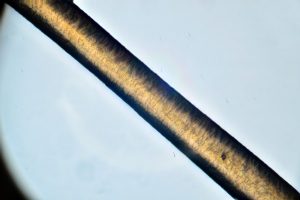You may have seen it on CSI: The star examines hair from a crime scene and concludes its color or texture looks like the defendant’s hair, or maybe his dog’s. Case closed. But, looks can be deceiving, as well as vague and subjective. According to Frank DelRio, and engineer at the National Institute of Standards and Technology (NIST), this is where the use of an atomic force microscope (AFM) may be able to play a significant role in forensic practices.
An atomic force microscope is a type of high resolution scanning probe microscope that has a resolution that can measure in fractions of a nanometer, more than 1000 times better than the optical diffraction limit. It was pioneered in 1986 by Nobel Prize Winner Gerd Binnig along with Calvin Quate and Christoph Gerber.
 Atomic force microscopy is arguably the most versatile and powerful microscopy technology for studying samples at nanoscale. It is versatile because an atomic force microscope can not only image in three-dimensional topography, but it also provides various types of surface measurements to the needs of scientists and engineers. It is powerful because an AFM can generate images at atomic resolution with angstrom scale resolution height information, with minimum sample preparation. It is designed to measure local properties, such as height, friction, and magnetism with a probe.
Atomic force microscopy is arguably the most versatile and powerful microscopy technology for studying samples at nanoscale. It is versatile because an atomic force microscope can not only image in three-dimensional topography, but it also provides various types of surface measurements to the needs of scientists and engineers. It is powerful because an AFM can generate images at atomic resolution with angstrom scale resolution height information, with minimum sample preparation. It is designed to measure local properties, such as height, friction, and magnetism with a probe.
AFMs operate by measuring force between a probe and the sample. Normally, the probe is a sharp tip, which is a 3-6um tall pyramid with 15-40nm end radius (Figure 1). Though the lateral resolution of AFM is low (~30nm) due to the convolution, the vertical resolution can be up to 0.1nm.
When imaging equipment is called upon to measure in nanometers, you can be confident that the precision lens designed and manufactured by Universe Optics will deliver the sharpest images possible. We not only manufacture lenses for atomic force microscopy, our Medical Imaging Lens assemblies include a standard offering of the most desired relay, 3 CCD relay, mounted and bare achromatic lenses.
To acquire the image resolution, AFMs can generally measure the vertical and lateral deflections of the cantilever by using the optical lever. The optical lever operates by reflecting a laser beam off the cantilever. The reflected laser beam strikes a position-sensitive photo-detector consisting of a four-segment photo-detector.
There are two primary modes of operation for an atomic force microscope. Namely, contact mode and non-contact mode, depending on whether the cantilever vibrates during the operation. In contact mode, the cantilever drags across the sample surface and it uses the deflection of the cantilever to measure the contours of the surface. In non-contact mode, the tip vibrates slightly above its resonance frequency and does not contact the surface of the sample. Any long-range forces, like van der Waals forces, decreases the resonant frequency of the cantilever.
According to DelRio, using AFM in forensics is all theoretical at this point. “For this to be an effective practical tool, a lot of baseline measurements and in-depth studies would need to be done to develop a good sense of how these properties change over time.” He also notes that calibration methods and standard samples or other methods for specifying accuracy would need to be developed to enable accurate comparison of measurements across laboratories. In the future, this could give law enforcement officials a more accurate look when studying such things as hair, and other small particles during an investigation.